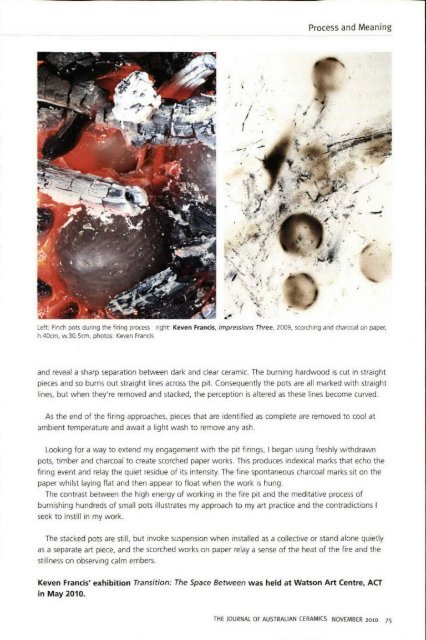The Journal of Australian Ceramics Vol 49 No 3 November 2010
You also want an ePaper? Increase the reach of your titles
YUMPU automatically turns print PDFs into web optimized ePapers that Google loves.
Process and Meaning<br />
Keven francis during firing process, 2009; photo: courtesy artist<br />
Working the Pit<br />
Keven Francis discusses process and meaning<br />
Risk, flames. smoke, sparks and spontaneity are the elements that excite and drive an obsession with<br />
the transformational power <strong>of</strong> fire and its influence on our physical and emotional perception.<br />
An immersion in the process <strong>of</strong> working the pit over several decades has enabled me to come to a<br />
strong conceptual framework based on the theme <strong>of</strong> transition. This theme is a common intent in my<br />
art practice across ceramics, painting and sculpture.<br />
I have become focused on a threshold or divide between states expressed as the strong hard edge<br />
produced by the fire's carbonisation <strong>of</strong> ceramic and timber. This sharp dividing line is integral to my work<br />
as it denotes a link between one existence, or experience, and another. This link can also be considered<br />
as a separate emotional and physical st ate in the space between before and after. such as the flux<br />
created by the burning fire-pit.<br />
My selection <strong>of</strong> palm-sized pinch pots as a medium <strong>of</strong> expression was driven by their potential to<br />
carry personal sensitivity and tactility <strong>of</strong> the artists' hand, and their robustness when confronted with<br />
movement during the firing process and radical temperature changes.<br />
My current ceramic work involves making hundreds <strong>of</strong> small burnished pinch pots that are pit-fired in<br />
groups <strong>of</strong> about 30 and installed as collectives <strong>of</strong> over 200 pieces. <strong>The</strong>y are placed on thick clear glass<br />
which is raised about 1 cm <strong>of</strong>f a paper base, providing tension between the weight <strong>of</strong> the pots and a<br />
sense <strong>of</strong> being suspended. In some installations, small pieces <strong>of</strong> charcoal are placed on the paper to<br />
increase the perception <strong>of</strong> elevation and as a direct reference to the pit-firing.<br />
Creating the palm-size pots is an obsessive process, with each piece gently moulded. then burnished,<br />
THE JOURNAL OF AUSTRALIAN CERAMICS NOVEMBER <strong>2010</strong> 73


















